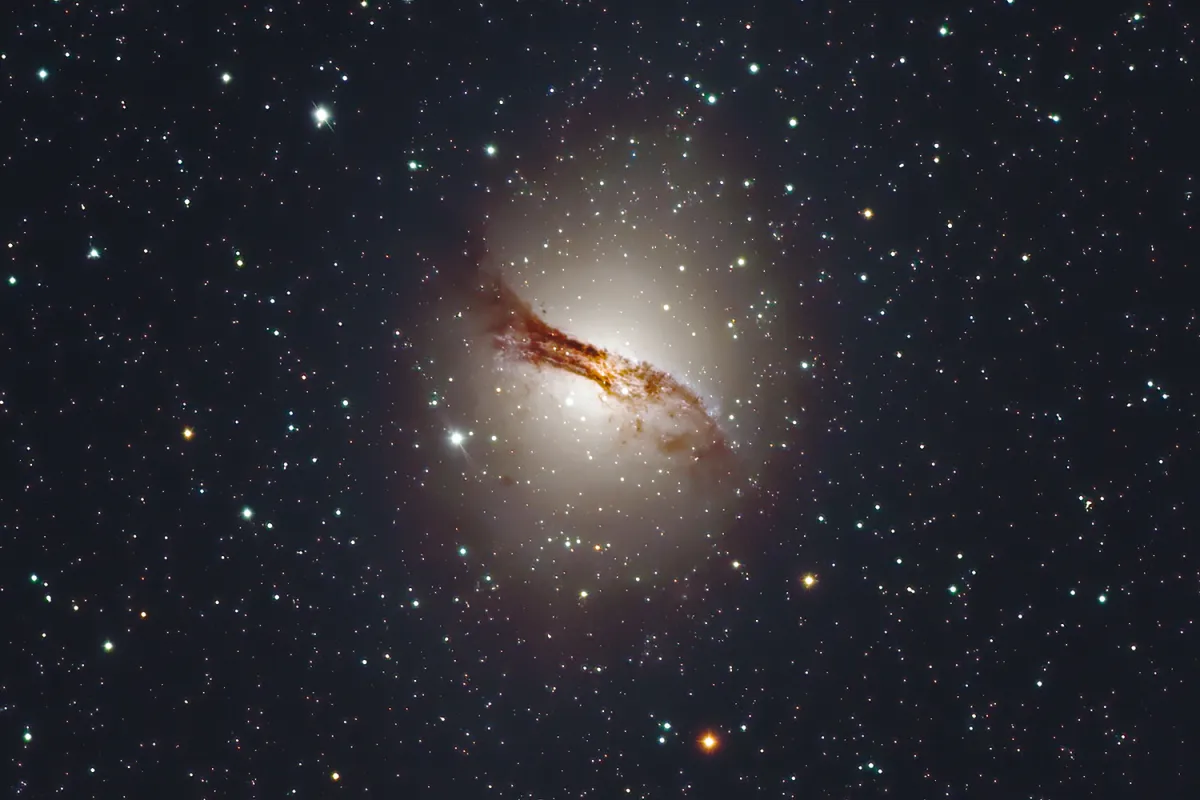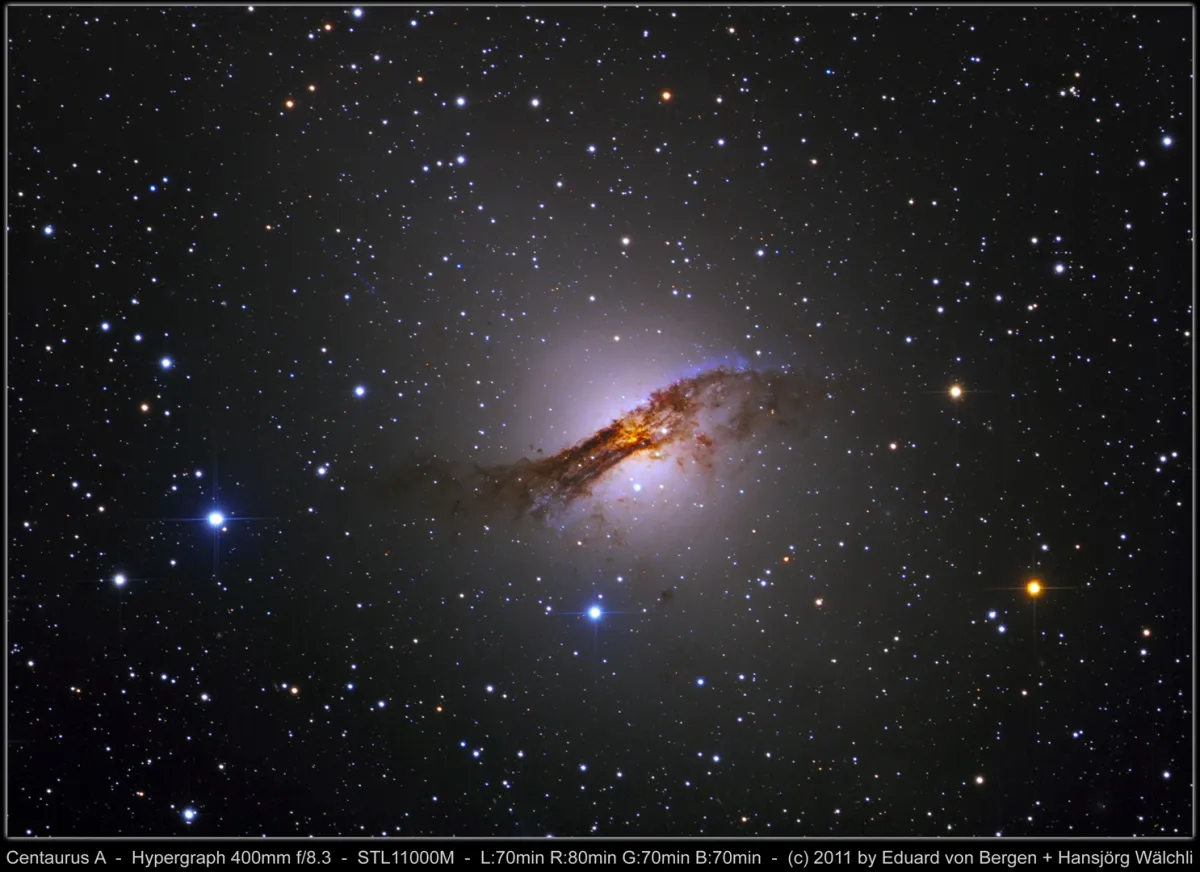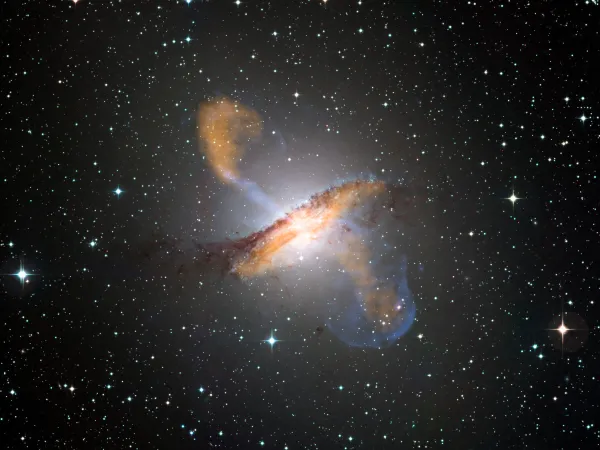Centaurus A (NGC 5128)



History
The galaxy NGC 5128 was discovered by Scottish astronomer James Dunlop on 29 April 1826 using the self-built 9-inch reflector at Parramatta observatory near Sydney, Australia. Based on six observation he recorded it as D 482 and described the object as follows: «A very singular double nebula, about 2.5' long and 1' broad, a little unequal: there is a pretty bright small star in the south extremity of the southernmost of the two, resembling a bright nucleus: the northern and rather smaller nebula is faint in the middle, and has the appearance of a condensation of the nebulous matter near each extremity. These two nebulae are completely distinct from each other, and no connection of the nebulous matters between them. There is a very minute star in the dark space between the preceding extremities of the nebula; they are extended in the parallel of the equator nearly.» [50]
John Herschel observing from South Africa he recored this object as h 3501 and wrote for sweep 454 (1 June 1834): «A most wonderful object; a nebula very bright; very large; little extended; very gradually much brighter middle; of an elliptic figure, cut away in the middle by a perfectly definite straight cut 40" broad; pos = 120.3; dimensions of the nebula 5' by 4'. The internal edges have a gleaming light like the moonlight touching the outline in a transparency.» On sweep 455 (3 June 1834) he wrote: «[Two nebulae, or two portions of one separated by a division or cut.] The cut is broad and sharp. The two nebulae are very nearly alike. Perhaps the slit is larger towards the north preceding end, where there is a star between them. There is certainly a very feeble trace of nebula, an island as it were, running from this star between the sides of the slit.» [11]
In Halton Arp's 1966 Atlas of Peculiar Galaxies, NGC 5128 is listed as Arp 153 in group #153-150 for an example of a disturbed galaxy with interior absorption. [199]

Physical Properties
Centaurus A (NGC 5128) is an elliptical, active radio galaxy, our nearest giant galaxy, at a distance of about 13 million light-years. It is currently merging with a companion spiral galaxy, which results in areas of intense tar formation. It has a very active and highly luminous central region, caused by the presence of a supermassive black hole. It is the source of strong radio and X-ray emission radiating from the jets and lobes emanating from the central black hole. The jets are travelling at approximately half the speed of light. A ring of dust is encircling the galaxy. [659]
| Designation | NGC 5128 |
| Type | Gx (S0/P) |
| Right Ascension (J2000.0) | 13h 25m 29.0s |
| Declination (J2000.0) | -43° 00' 58" |
| Diameter | 25.7 × 20 arcmin |
| Photographic (blue) magnitude | 7.8 mag |
| Visual magnitude | 6.8 mag |
| Surface brightness | 13.5 mag·arcmin-2 |
| Position Angle | 35° |
| Redshift (z) | 0.001825 |
| Distance derived from z | 7.71 Mpc |
| Metric Distance | 3.660 Mpc |
| Dreyer Description | !!, vB, vL, vmE 122°.5, bifid |
| Identification, Remarks | h 3501; GC 3525; ESO 270-9; MCG -7-28-1; Arp 153; IRAS 13225-4245; AM 1322-424; PRC C-45; Centaurus A |
Finder Chart
The galaxy NGC 5128 is located in the constellation Centaurus, roughly 4.5° north of the giant globular cluster Omega Centauri which is visible to the naked eye. At a declination of -43° the is not visible from Europe. On 13 April it in opposition with the Sun and is therefore highest in the sky at around midnight.
Visual Observation
Binoculars: The galaxy is surprisingly well visible as a round, diffuse spot with a dark stripe across it, when sweeping north from Omega Centauri. — Astrofarm Tivoli, Namibia, September 2023, Bernd Nies
635 mm Aperture: At first glance I checked whether someone had smuggled a slide into the eyepiece of the telescope. The galaxy NGC 5128 looks exactly how one remembers it from the many pictures seen in books! A diffuse, elliptical galaxy inmidst thousands of brilliant stars. The warped band of dust shows many fine details. It is a very phantastic sight, allowing higher and higher magnifications. — 25" f/4 Obession Dobsonian, Astrofarm Tivoli, Namibia, September 2023, Bernd Nies
